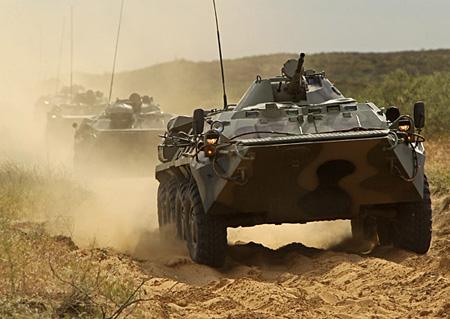The Associated Press specified "a dozen armored vehicles", while France Presse reported observing the passage of a column of "ten armored vehicles" heading towards the Donetsk border crossing.
The British Guardian and Telegraph journalists, on the spot, counted 23 armored personnel carriers, tank trucks and other logistics vehicles.
Based on these testimonies, these means became responsible for crossing the Ukrainian border during the night.
Absolute confirmation of this event is the statement by NATO Secretary General Anders Fogh Rasmussen: "Last night we saw a Russian incursion, a crossing of the Ukrainian border near Izvarino. I think it's just the continuation of what we've been seeing for some time, a flow of supplies ".
If it is not an intervention for humanitarian purposes, it is an event in which it is possible to find a series of tactical inconsistencies: first of all, a column of incursor vehicles that penetrates hostile territory, be it humanitarian or composed of occupation troops, must be adequately escorted and protected. One of the fundamental principles in military doctrine, is the safeguarding of its soldiers, but the convoy was partially overwhelmed by the enemy, therefore, the armored vehicles were neither numerically sufficient, nor adequately armed to perform this task, nor protected by the necessary air cover; more precisely, the troop transport vehicles did not have the escort of the MBTs, and the aircraft for the interdiction on the ground, were not placed in a state of operational readiness to intervene where the column was placed under attack by opposing forces. This allows a decrease in enemy fire on the raiders and the creation of a corridor to allow their retreat.
The column was not completely destroyed, and this means that they had not penetrated deeply, otherwise they would have been surrounded and annihilated. The convoy, therefore, was intercepted when the distance from the Russian border was still such as to facilitate a makeshift maneuver, and of course this would have allowed ground support for the column under attack, but this activity is not reported by witnesses.
To suppose that the Russian decision makers did not intervene to help the military penetrated into hostile territory, to avoid raising the level of confrontation, does not seem plausible. Moreover, where the number of armored vehicles was equal to 23 unit, that is the major declared by journalists, it could not be an invasion force, because the amount of personnel transported would have been insufficient for the purpose.
Another hypothesis is that it was a false flag, diverting attention from different purposes. Therefore, if the events took place as reported by journalists and the official Ukrainian statement, the Russian chain of command would have failed dramatically in the mission due to inadequate planning.
Giovanni Caprara
(photo: Russian Fed. MoD archive)












